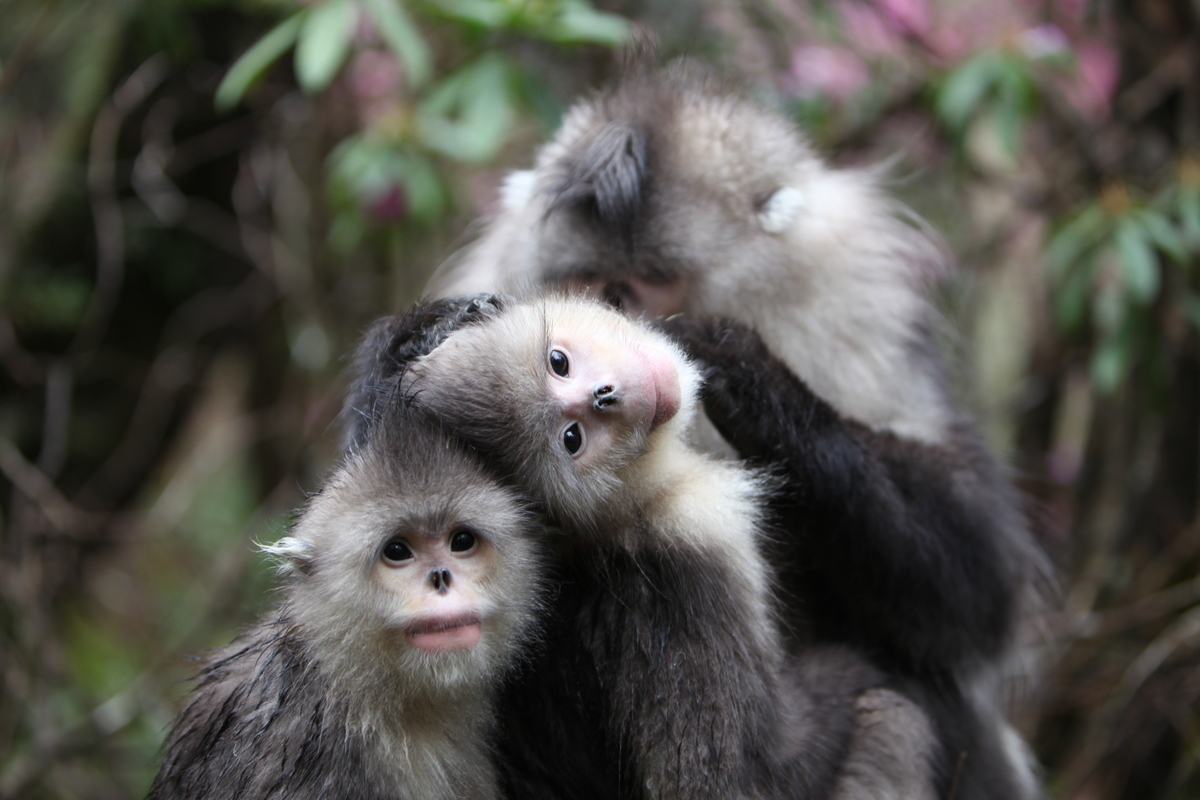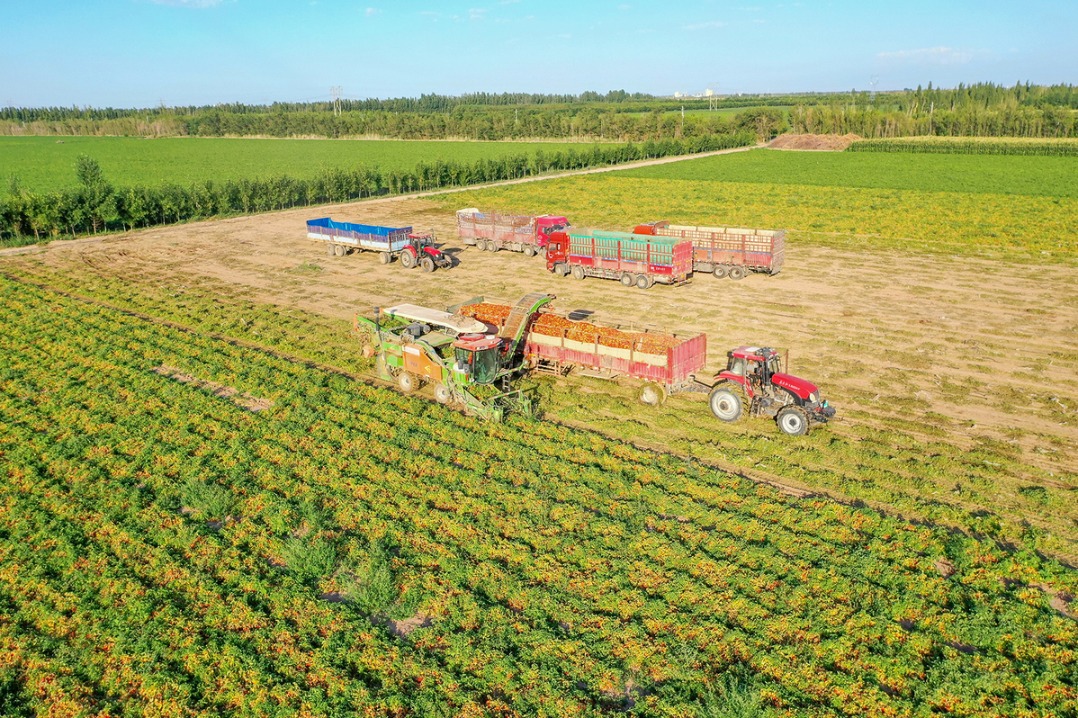Biodiversity Conservation in China


Editor's Note: The State Council Information Office of the People's Republic of China on Friday released a white paper titled "Biodiversity Conservation in China". Full text below:
Contents
Preface
I. Harmony Between Humanity and Nature
II. Increasing the Efficiency of Biodiversity Conservation
III. Improving Biodiversity Governance
IV. Further Global Cooperation on Biodiversity Conservation
Conclusion
Preface
Biodiversity refers to the variety of living species (plants, animals and microorganisms) in their natural environments and the aggregate of the related ecological processes. It is measured on three levels: genes, species and ecosystems. Biodiversity is the basis for human survival and development and has a direct bearing on our wellbeing. Humans must respect nature and follow its ways. We must conserve biodiversity to protect nature and live in harmony with it.
In 1972, at the United Nations Conference on the Human Environment, the attending nations signed the Declaration of the United Nations Conference on the Human Environment, which included the conservation of bio-resources in its 26 principles. In 1993, the Convention on Biological Diversity came into effect, which set three objectives-the conservation of biological diversity, the sustainable use of its components, and the fair and equitable sharing of the benefits arising out of the utilization of genetic resources, ushering in a new era for the protection of global biodiversity.
China's land and sea territories are both vast; its complex terrain and diverse climate gave birth to unique ecosystems, abundant species, and rich genetic variety. As one of the most biodiverse countries in the world, China has a profound understanding of biodiversity, as manifest in traditional Chinese culture and these aphorisms: "Man is an integral part of nature"; "Dao follows the laws of nature"; and "All beings are equal". China, as one of the first countries to sign and approve the Convention on Biological Diversity, has always attached great importance to biodiversity conservation and preserves biodiversity with creative and up-to-date measures, achieving substantial progress on a distinctively Chinese path of conservation.
Since the 18th National Congress of the Communist Party of China (CPC) in 2012, China has been prioritizing eco-environmental progress and pursuing green development under the guidance of Xi Jinping thought on eco-civilization. A new pattern of biodiversity conservation has largely taken shape, with improvements to the legal system, supervision mechanisms and governing capacity for eco-conservation, marking the beginning of a new era for biodiversity conservation in China. Currently, as species worldwide are becoming extinct at an alarming rate, biodiversity loss and ecosystem degradation pose a major risk to human survival and development. On September 30, 2020, at the United Nations Summit on Biodiversity, Chinese President Xi Jinping pointed out that the whole of humanity needs to take on its pressing responsibilities, find a way for human and nature to coexist in harmony, and build synergy for and enhance global governance on the environment. Guided by the vision of building a global community of shared future, China will continue to contribute its part to global environmental governance.
The Chinese government is publishing this white paper to present China's ideas, plans and actions on biodiversity conservation, and share its progress with the international community.
I. Harmony Between Humanity and Nature
To realize the Beautiful China initiative under a new situation, China is improving the measures for biodiversity conservation and creating new frameworks for this purpose. In its pursuit of harmony between humanity and nature, between individuals, and between the individual and society, China endeavors to create a virtuous circle for all-round development and prolonged prosperity for all.
In addressing biodiversity loss and ecosystem degradation, China upholds the philosophy of harmonious coexistence between humanity and nature, prioritizing biodiversity conservation and seeking green development. It has established conservation mechanisms led by the government and featuring multilateral governance and win-win cooperation, in which all citizens participate. This way, China keeps making progress and contributing to efforts in global biodiversity conservation.
· Respecting nature and prioritizing biodiversity conservation. China follows the principles of respecting and protecting nature and obeying nature's laws, and prioritizes biodiversity conservation in social development. Given its eco-environment and natural resources, China has balanced its natural and artificial measures for the conservation and restoration of important ecosystems, species and genetic resources, to ensure ecological security and biological security.
· Seeking green development and sustainable utilization of bio-resources. China cherishes the principle that lucid waters and lush mountains are invaluable assets, and sees biodiversity as the foundation, objective and means of sustainable development. It has endeavored to promote the efficient and sustainable utilization of bio-resources, to allow nature to restore itself. It promotes green ways of life and work, and seeks development opportunities while preserving nature, to achieve win-win results in both biodiversity conservation and high-quality development.
· Enhancing institutional guarantee and coordinating actions for biodiversity conservation. China has strengthened biodiversity conservation as a national strategy through long-range planning and top-level design, specifying the primary responsibilities at all levels, and improving long-term conservation mechanisms led by the government and facilitated by enterprises with public participation. The China National Committee for Biodiversity Conservation (CNCBC) has taken on a stronger coordinating role. Constant efforts have been made to improve laws, regulations and policies concerning biodiversity conservation, sustainable utilization of bio-resources, and fair and equitable sharing of benefits. All the above efforts are aimed at building a new model for biodiversity conservation and governance.
· Upholding multilateralism and win-win cooperation. Living in harmony with nature through greater efforts on biodiversity conservation becomes an important topic for international exchanges and dialogue. China firmly supports a multilateral biodiversity governance system, fulfills its obligations prescribed in the Convention on Biological Diversity and other environmental treaties, and takes on international responsibilities commensurate to its development stage. China has been providing assistance within its ability to other developing countries, and strengthening exchanges and cooperation on biodiversity to jointly meet global challenges. It endeavors to play a greater role in realizing the vision of harmony between humanity and nature.
II. Increasing the Efficiency of Biodiversity Conservation
China advances biodiversity conservation and development in parallel. It has proposed and implemented measures such as building the national parks system and setting ecological conservation red lines (ECRLs), strengthened in-situ and ex-situ conservation, reinforced biological security management, improved the eco-environment, and coordinated the conservation of biodiversity with green development, thereby making significant gains in protecting biodiversity.
1. Optimizing In-situ Conservation
China is setting up protected areas (PAs) and opening national parks on a trial basis, to create a PA framework with a focus on national parks. It was the first in the world to propose and implement the red line strategy for ecological conservation, and has designated priority areas in biodiversity conservation. These measures have contributed to the conservation of key natural ecosystems, biological resources, and habitats for key species.
Developing a PA system with a focus on national parks. Since 1956 when the first nature reserve was set up, China has established close to 10,000 PAs of all types and at all levels, accounting for about 18 percent of its total land area. In recent years, it has built a PA system with national parks as the mainstay, supported by nature reserves and supplemented by nature parks, laying the foundation for protecting natural habitats, improving the eco-environment, and protecting ecological security in the country. Since 2015, it has launched on a trial basis 10 national parks, including one at Sanjiangyuan, the cradle of the Yangtze, Yellow and Lancang rivers. The relevant PAs have been integrated into these national parks under unified management, comprehensive protection and systematic restoration.
The well-planned PA system has brought 90 percent of terrestrial ecosystem types and 71 percent of key state-protected wildlife species under effective protection. The habitats for wild animals have been expanding and their populations are growing. The population of giant pandas in the wild has grown from 1,114 to 1,864 over the past four decades. The crested ibis population has increased from only 7 to over 5,000, with both wild species and artificial breeds counted. The Asian elephant population in the wild has grown from 180 in the 1980s to about 300 at present. The wild population of Hainan Gibbon has increased from no more than 10 in two groups 40 years ago to 35 in 5 groups.
Panel 1: Piloting the National Parks System
In 2015, China began to pilot the national parks system based on 60 years of experience with PAs. It has established on a trial basis 10 national parks in Sanjiangyuan and other places across the country, covering a total area of 220,000 sq km, or 2.3 percent of the total land area.
China designates certain land or sea areas as national parks to provide effective protection for the ecosystems most representative of the country and for the conservation and sound utilization of natural resources therein. They showcase the best and most important parts of the country's ecosystems with unique landscape and diverse forms of life. They cover a large area and demonstrate complete, wholesome ecological processes. While applying the strictest measures in eco-environmental protection, they are also bases for scientific research, education, and recreation.
After years of trial run, the national parks have achieved remarkable results in setting up management systems, innovating operation mechanisms, strengthening supervision and administration, and coordinating development. The relevant PAs have been integrated into these national parks under unified management, comprehensive protection and systematic restoration, strengthening the conservation of the holistic ecosystems in their original forms. This reform has also contributed to establishing a comprehensive PA system with a focus on national parks in the future.
Setting and applying red lines for ecological conservation. Setting ECRLs is an important institutional innovation in China's land use planning and eco-environmental reform. China employs this innovative model to bring essential ecological functional areas for biodiversity conservation and the most ecologically fragile regions under the ECRLs and apply stringent conservation measures to them. The areas initially defined under the initiative are mainly distributed across China's ecological security barriers and areas such as the Qinghai-Tibet Plateau, Tianshan Mountains, Inner Mongolian Plateau, Greater and Lesser Xing'an Mountains, Qinling Mountains, Nanling Mountains, Yellow River Basin, Yangtze River Basin, and coastal zones. At present, they cover various important ecosystems such as forests, grasslands, deserts, wetlands, mangrove forests, coral reefs and sea grass beds across key regions of biodiversity all over the country, bringing most rare and endangered species and their habitats under protection.
China's proposal-Drawing a "Red Line" for Ecological Protection to Mitigate and Adapt to Climate Change-has been selected by the UN as one of the 15 best Nature-based Solutions around the globe. Drawing ECRLs and biodiversity protection are strategies for the same goals in the same areas. Setting red lines will effectively improve the function of ecosystems and maintain the basic ecological space necessary for national ecological security and sustainable economic and social development.
Designating priority areas for biodiversity protection. China is connecting the current PAs across different administrative regions. Giving full consideration to key biogeographical components and different types of ecosystems, it has designated 35 priority areas for biodiversity protection. Among these, 32 terrestrial priority areas cover a total of 2.76 million sq km and make up about 28.8 percent of the total land area. They are valuable in effectively protecting key ecosystems, species and their habitats.
2. Improving Ex-situ Conservation
China continues to step up ex-situ conservation, and launches systematic campaigns to save endangered species. More biological genetic resources are collected and better preserved, and the ex-situ conservation system is improving as an effective complement to in-situ conservation, helping to protect and restore many species of endangered wildlife.
Gradually improving the ex-situ conservation system. China has set up a relatively complete ex-situ conservation system including botanical gardens, wildlife rehabilitation and breeding centers, germplasm resource centers, and gene banks. To date, China has built a total of about 200 botanical gardens and arboretums exhibiting 23,000 species of plants, and 250 wildlife rehabilitation and breeding centers where over 60 types of rare and endangered wild animal are successfully bred.
Panel 2: Ex-situ Conservation of Plants
China has set up a relatively complete ex-situ conservation system for plants. It has grown 23,340 species (including subspecies) of higher plants under 3,633 genera of 396 families through ex-situ methods, among which are some 20,000 indigenous species (60 percent of the total higher plants native to China) under 2,911 genera (86 percent) of 288 families (91 percent). It has built about 200 ex-situ conservation sites and completed basic collection and preservation of germplasm resources of sago cycad, palm, and key orchidaceae and magnoliaceae plants native to China. It has built 22 integrated genetic resource banks of multiple tree species, 13 dedicated genetic resource banks of single tree species, and 294 national centers for forest superior varieties, preserving over 2,000 varieties of trees across most provinces and covering 60 percent of the genetic resources of main tree species used for afforestation.
Accelerating the collection, preservation and use of key genetic resources. China attaches great importance to protecting biological resources, and has made considerable progress in the research on biological resources and their collection and preservation in recent years. To steadily increase protection and use of wildlife resources, China has rolled out special plans for strategic biological resources, which have helped to improve bio-resource collection and preservation platforms, and create platforms for germplasm resource innovation and natural compound transformation as well as libraries for derivatives of genetic resources. It has launched a batch of projects for germplasm resource protection and breeding. By the end of 2020, China had put in place a national crop genetics protection system with the national long-term germplasm banks and their duplicates as the core, supported by 10 medium-term banks and 43 germplasm fields. It had built 199 state-level livestock and poultry germplasm resource preservation fields (areas, storehouses), preparing state-level sites for the conservation of germplasms of over 90 percent of breeds under the National Catalogue of Livestock and Poultry Genetic Resources. There are over 520,000 copies of crop germplasm resources and 960,000 copies of livestock and poultry genetic resources in long-term storage. China has established 99 state-level germplasm resource banks for trees, and two state-level germplasm resource sub-centers for trees and grass in Xinjiang and Shandong, preserving 47,000 copies of germplasm resources for trees. It has also built 31 germplasm preservation fields and two germplasm resource centers for medicinal plants, preserving over 12,000 copies of seeds and seedlings.
Panel 3: Germplasm Bank of Wild Species in Southwest China
The Germplasm Bank of Wild Species in Southwest China, a world-class preservation system for germplasm resources of wild species, was founded after 13 years of combined efforts on the part of 105 units nationwide, coordinated by Kunming Institute of Botany affiliated to the Chinese Academy of Sciences. It helps to collect and preserve a large number of rare, endangered biological germplasm resources unique to China and of great value, with its resources and information accessible by all. By the end of 2020, the bank had preserved 85,046 wild plant seeds of 10,601 species; 24,100 vitro culture plants of 2,093 species; 65,456 DNA materials of 7,324 types; 22,800 microbial strains of 2,280 types; and 60,262 copies of animal germplasm resources of 2,203 types. It has become an important site for global biodiversity protection together with the UK Millennium Seed Bank and Norway Svalbard International Seed Vault.
Launching well-planned campaigns to save endangered species. China has launched campaigns to rescue rare and endangered wildlife, expand their population through artificial breeding, and reintroduce them to natural habitats in a phased manner. The captive population of breeding pandas has grown in numbers and quality. They have been downgraded from "endangered" to "vulnerable" on the list of species at risk of extinction, and some have been released into natural habitats to integrate into the wild population. Elks, once nowhere to be found in the wild, have grown to 8,000 in number thanks to the three conservation bases in Nanhaizi of Beijing, Dafeng of Jiangsu, and Shishou of Hubei. Emergency measures have also been taken to save and protect 120 plant species with extremely small populations such as the Cycas debaoensis, Manglietiastrum sinicum and Abies beshanzuensis, and to restore to their natural habitats 112 species of rare and endangered wild plants native to China.
3. Improving Biosecurity Governance
China attaches great importance to biosecurity, and has included it in the national security system. The Biosecurity Law was promulgated and came into force in 2021. There is systematic planning for biosecurity risk control and governance. Efforts have been made to improve the mechanism for preventing the invasion of alien species, promote the sound development of biotechnologies, and strengthen the protection, supervision and regulation of biogenetic resources. The aim is to constantly improve national biosecurity governance.
Preventing the invasion of alien species. China has made greater efforts to guard against and respond to the invasion of alien species. It has improved the collective response to invasive alien species by putting in place inter-ministerial coordination mechanisms. China issued the List of Invasive Alien Species in China in four groups in 2003, 2010, 2014 and 2016 respectively, and the List of Key Invasive Alien Species under State Supervision in 2012, covering a total of 83 invasive species detected in the country. China has brought invasive alien species under survey, monitoring, early warning, control and extermination. Stronger port quarantine measures have helped to prevent the entry of invasive alien species and reduce the risk of wildlife epidemics.
Improving safety administration of genetically modified organisms (GMOs). China has tightened the regulation of biotechnologies and bio-products, and promoted the sound and orderly development of biotechnologies. A succession of laws and regulations have been promulgated, including Regulations on the Safety Administration of Genetically Modified Organisms in Agriculture (2001), Measures for the Safety Assessment and Administration of Genetically Modified Organisms in Agriculture (2002), Measures for the Safety Administration of Biotechnology Research and Development (2017), and Measures for the Administration of Inspection and Quarantine of Inbound and Outbound Genetically Modified Products (2004). Safety testing and assessment of GMOs has been conducted to prevent any potential negative impact on biodiversity conservation and on the sustainable utilization of bio-resources resulting from the release of GMOs into the environment. With the issuance of over 200 technical norms on the safety testing, assessment, supervision and regulation of GMOs, a national system of GMO safety administration is being completed in steps.
Strengthening the supervision of biogenetic resources. China has tightened management and oversight on the conservation, acquisition, utilization and benefit-sharing of biogenetic resources. China has conducted surveys on essential biogenetic resources and conservation performance evaluations, to identify the scale, distribution, conservation and utilization of these resources.
· China organized the fourth national survey on Traditional Chinese Medicine (TCM) resources in 2018, and pinpointed the genetic affiliation and distribution of over 13,000 varieties, including 3,150 varieties unique to China.
· China is conducting the third national survey on and collection of crop germplasm resources (2021-2023), with a total of 92,000 samples having been collected, more than 90 percent of which are newly identified varieties.
· China is conducting the third national survey on livestock and poultry genetic resources (2021-2023), and has completed the preliminary identification of 8 new species.
· China launched the first national survey on forest and grass germplasm resources in 2019, and has completed a pilot survey in the nature reserves along the Qinling Mountains.
In the past decade, China has identified about 200 new varieties of plants per annum, accounting for 10 percent of the global figure. China is accelerating legislation on accessing and sharing the benefits of biogenetic resources, strengthening their conservation, supervision and regulation, and preventing their loss or chaotic utilization.
4. Improving the Eco-environment
Improving and stabilizing ecosystems plays a fundamental and strategic role in ensuring national ecological security. China has therefore intensified efforts in eco-environmental conservation and restoration, and launched a series of projects for the integrated conservation and restoration of mountains, rivers, forests, farmland, lakes, grasslands, deserts, glaciers and snow mountains. As a result, ecological deterioration has been contained, and ecosystems are generally stable, with a greater capacity to serve development. China has been fighting a tough battle against pollution; currently, the pressure on biodiversity conservation is greatly eased, the eco-environment keeps improving, and a framework of shields for ecological security has been largely completed.
Implementing eco-environmental conservation and restoration projects. To restore degraded ecosystems, and improve and stabilize them, China has carried out multiple conservation and restoration projects, which have succeeded in improving and restoring wildlife habitats in key regions.
· China has implemented key ecosystem-related projects including conservation and restoration of natural forests, sandstorm source control in Beijing and Tianjin, stony desertification control, the Three-North (i.e., Northeast China, North China and Northwest China) Shelterbelt Forest Program and other key forest programs, programs turning marginal farmland into forests and grasslands, programs returning grazing lands to grasslands, conservation and restoration of lakes, rivers and inland wetlands, and conservation and restoration of mangrove forests and coastal wetlands.
· China has launched 25 pilot projects and 10 integrated projects for the conservation and restoration of mountains, rivers, forests, farmland, lakes, grasslands, and deserts.
· China has enacted the Master Plan on Major Projects for the Conservation and Restoration of National Key Ecosystems (2021-2035), specifying an overall conservation configuration for the new era composed of Three Eco-zones and Four Shelterbelts-Qinghai-Tibet Plateau Eco-zone, Yellow River Eco-zone, Yangtze River Eco-zone, Northeast Shelterbelt, North Shelterbelt, South Shelterbelt, and Coastal Shelterbelt.
Through the above actions, China has achieved the following:
· China's forest coverage and forest reserve have both maintained growth for the last 30 years, and China has realized the largest growth in forest resources among all countries in the world.
· China's desertification coverage and sandy desertification coverage have both decreased in three successive monitoring periods. Its steppe vegetation coverage rate has reached 56.1 percent and the steppe ecosystems have continued to improve.
· Between 2016 and 2020, China restored 1,200 km of coastline and 23,000 ha of coastal wetlands.
· Between 2000 and 2017, China contributed about 25 percent of global vegetation growth, the biggest share among all countries.
Tightening pollution control. Good environmental quality is both the foundation and goal of biodiversity conservation. China has announced a battle against pollution to improve air, water and soil quality. Through an increasing effort to combat pollution, China has achieved the following:
· In 2020, China's average concentration of ambient particulate matters (PM2.5) was 33 μg/m3, down by 28.3 percent from 2015, and the percentage of days with good air quality rose by 5.8 percentage points from 2015.
· In 2020, the combined proportion of state-controlled water sections with good-quality surface water reaching Grades I, II and III was 83.4 percent, up by 17.4 percentage points from 2015; and that of water sections with bad quality surface water below Grade V was 0.6 percent, down by 9.1 percentage points from 2015.
· In 2020, the combined proportion of good quality offshore waters reaching Grades I and II was 77.4 percent in terms of area, up by 9 percentage points from 2015.
· In 2020, the safe utilization rate of contaminated arable land and that of contaminated land both exceeded 90 percent.
A better eco-environment has provided better wildlife habitats, which has helped restore the functions of varied ecosystems and greatly eased the pressure from biodiversity loss.
5. Promoting Green Development with Coordinated Efforts
China endeavors to advance social and economic development within the carrying capacity of supporting ecosystems. Measures have been taken to transform the economic growth model, encourage green and low-carbon ways of life, and coordinate efforts in biodiversity conservation and high-quality development.
Accelerating the green transformation of all sectors and industries. Upholding the new development philosophy, China pursues green development with the priority given to eco-environmental conservation. Efforts have been made to promote the green transformation of all sectors and industries in social and economic development, to balance economic development with eco-environmental protection, and to reduce the pressure on biodiversity.
China is moving faster in building an economic structure that facilitates green, low-carbon and circular development, aiming to improve industrial structure, raise the efficiency of resource utilization, promote cleaner production, increase the proportion of green industries, and accelerate the green transformation and upgrading of primary, secondary and tertiary industries and their infrastructure.
China encourages eco-friendly planting and breeding industries and sustainable operations. It has formulated guidelines on sustainable production for better conservation of bio-resources. It has improved the certification of green products such as green food, organic farm produce, forest products with ecolabels, and sustainable aquaculture products. China is leveraging innovative technology in protecting biodiversity, and sustainably utilizing bio-resources in the fields of agriculture, forestry, fishery and animal husbandry.
China has put in place systems for the utilization and administration of key wildlife resources, such as hunting licenses, collecting permits, and domesticating and breeding certificates, and encourages conservation and sustainable utilization of premier bio-resources.
Promoting green urban and rural development. China is coordinating its efforts in biodiversity conservation and rural revitalization, with the former as a precondition. It has endeavored to explore competitive resources, develop eco-friendly industries, promote green and high-quality development in both urban and rural areas, and build a beautiful homeland featuring harmonious coexistence of humanity and nature.
China takes into full account eco-environmental factors in the process of rural revitalization. With an aim to promote rural progress and improve farmers' living standards, it has redoubled efforts in preserving bio-resources, as a means of facilitating sustainable development.
China is building national demonstration zones for eco-environmental progress, national model cities for environmental protection, national eco-park cities, and national park cities. The aim is to strengthen biodiversity conservation in urban areas, optimize the urban ecological spatial configuration, improve urban ecosystems, and enhance the people's sense of gain, happiness and security from the eco-environment.
China has been encouraging green and low-carbon ways of life, such as green consumption, green travel and green housing, to reduce the consumption of natural resources.
Realizing the market value of green products. Practicing the concept that lucid waters and lush mountains are invaluable assets, China has worked to realize and increase the market value of green products, and seek new growth engines for high-quality development.
China has established a sound mechanism for realizing the market value of green products, and is working on a policy framework for turning "lucid waters and lush mountains" into "invaluable assets".
China has piloted mechanisms for the marketing of green products in the Yangtze River Basin and Sanjiangyuan National Park, and established bases for turning natural resources into economic gains. Efforts have been made to devise marketing strategies for green products, which are overseen by the government, adapted to commercialized operation, and support sustainable development, and in which enterprises and all sectors of society participate. The aim is to turn eco-environmental strengths into growth drivers for quality development and motivate the public to preserve biodiversity.
Panel 4: Cases on Biodiversity Conservation Facilitating Poverty Reduction
Wufeng Tujia Autonomous County in Hubei Province is located in a key area of biodiversity. By integrating beekeeping and the cultivation of nectar plants with biodiversity conservation, local farmers have seen income increases and have since lifted themselves out of poverty. The per capita disposable income of permanent rural residents increased from RMB7,880 in 2015 to RMB11,735 in 2020. In 2019, this case was selected into the list of 110 best poverty reduction cases from the first Global Solicitation on Best Poverty Reduction Practices, jointly launched by the World Bank, the Food and Agriculture Organization of the United Nations, among others.
Weichang Manchu and Mongolian Autonomous County, Hebei Province, has an abundance of forestry resources. The local government organized the poor with the capacity to work to participate in site preparation, tree-planting and forest protection, so as to increase their incomes; while poor individuals with the appropriate qualifications have been employed as forest rangers at a steady income of RMB7,000-8,000 per person per year.
III. Improving Biodiversity Governance
Biodiversity conservation has been elevated to a national strategy in China, and incorporated into mid- and long-term plans of all regions and fields. There has been a drive to improve the legal and policy framework, strengthen technical support and the training of high-caliber personnel, expand oversight on law enforcement, and encourage public participation in conserving biodiversity, thus improving biodiversity governance.
1. Improving Relevant Policies, Laws and Regulations
China is making constant efforts to establish and improve policies, laws and regulations on biodiversity conservation, and has drafted mid- and long-term programs and action plans to provide institutional guarantees for biodiversity conservation and management.
Strengthening organization and leadership. The China National Committee for Biodiversity Conservation (CNCBC) has been established to coordinate conservation actions. It is composed of 23 departments under the State Council, and headed by a Vice Premier who is in charge of environmental protection. To strengthen the quality and stability of our ecosystems, the Outline of the 14th Five-Year Plan (2021-2025) for National Economic and Social Development and the Long-Range Objectives Through the Year 2035 make provisions for implementing major biodiversity conservation projects and building a biodiversity conservation network.
The China National Biodiversity Conservation Strategy and Action Plan (2011-2030) has been issued and implemented, offering substantial guidance in 10 priority areas, including the policy and legal framework for biodiversity conservation and sustainable utilization of bio-resources, and 30 actions, including inter-departmental coordination mechanisms. Beijing, Jiangsu, Yunnan and 19 other provincial-level administrative units have formed local strategies and action plans accordingly.
China has put in place a system for evaluating performance in advancing ecological progress, based on which indicators of biodiversity conservation have been included in performance evaluation for local governments, urging them to fulfill their responsibilities for biodiversity conservation.
Strengthening the legal system for biodiversity conservation. Over the past decade, China has promulgated and revised more than 20 laws and regulations pertinent to biodiversity conservation, including laws on forestry, grassland, fishery, seed, biosecurity as well as laws on the protection of wild animals, the environment, marine environment, and the Yangtze River, covering the protection of wildlife and important ecosystems, biosecurity, access to and benefit-sharing of biogenetic resources, thus providing solid legal safeguards for biodiversity conservation and sustainable utilization of bio-resources.
China has also revised the list of key wild animals and plants under state protection, laying a foundation for rescuing rare and endangered wildlife and maintaining biodiversity. In 2020, the Standing Committee of the 13th National People's Congress adopted at its 16th session the Decision to Comprehensively Prohibit the Illegal Trade of Wild Animals, Eliminate the Bad Habits of Wild Animal Consumption, and Protect the Health and Safety of the People.
Different provinces and equivalent administrative units have issued relevant regulations based on local conditions. Yunnan Province, for example, formulated its own biodiversity conservation regulation, the first local one in the country.
2. Extending Guarantees
China has organized nationwide biodiversity surveys, and put in place sound biodiversity monitoring and observation networks. It has increased financial input and effort in technology research and development to improve the capacity for biodiversity conservation and governance.
Conducting nationwide biodiversity surveys and assessment. To improve its biodiversity survey and assessment capacity, China has carried out major biodiversity conservation projects, in addition to surveys of natural resources and the monitoring and assessment of ecosystems. It has included biodiversity indicators in the system of comprehensive assessment indexes for ecological quality for the first time to guide local governments in protecting the eco-environment and biodiversity. A system for surveying, assessing and monitoring natural resources has been developed, and surveys on forests, grasslands, waters, wetlands, deserts, oceans and other natural resources have been carried out.
China has built a species distribution database, covering 2,376 county-level administrative units and totaling over 34,000 km in line transect. An information platform has been set up to survey and collect various species, accurately mapping the spatial distribution of wildlife.
China has completed biodiversity surveys and assessment in more than 180 county-level administrative units in the Yangtze River Economic Belt, Beijing-Tianjin-Hebei Region and some other national strategic areas. Offshore resources studies have been carried out to build an initial profile of fishery resources.
China has released the China Red Data Book of Plants, China Red Data Book of Endangered Animals, China Species Red List, and China's Red List of Biodiversity to establish the overall situation of biodiversity and lay a scientific basis for better biodiversity conservation.
Panel 5: China's Red List of Biodiversity
To build a comprehensive profile of all the species and make biodiversity conservation more rational and effective, China carried out a nationwide survey involving more than 600 experts to assess 34,450 higher plant species (including subspecies), 4,357 vertebrate species, and 9,302 macrofungi species in China. They have improved the assessment standards, defined the level of threat, and analyzed the causes of threats. China's Red List of Biodiversity: Higher Plants was published in September 2013, China's Red List of Biodiversity: Vertebrates in May 2015, and China's Red List of Biodiversity: Macrofungi in May 2018.
Improving monitoring and observation networks. China has put in place monitoring and observation networks for various ecosystems and species. These networks have played an important role in supporting biodiversity research, demonstrating and promoting relevant technology, and protecting species and their habitats, thereby providing diverse information services and decision-making support for scientific research and education, popularizing science and exploiting resources. Among them, the Chinese Ecosystem Research Network (CERN) and the Chinese Terrestrial Ecosystem Research Network (CTERN) cover all ecosystems and elements; the China Biodiversity Monitoring and Research Network (Sino BON) covers a variety of biological groups such as animals, plants and microorganisms; the China Biodiversity Observation Network (China BON) has designated plots for the observation of indicator species all over the country.
Panel 6: Chinese Ecosystem Research Network
Since 1988, the Chinese Ecosystem Research Network (CERN) has set up 44 stations in different ecological zones all over the country, covering forests, grasslands, deserts, wetlands, farmland, cities and other ecosystems. It has put in place an ecological observation system consisting of 48 comprehensive observation sites, 120 supplementary observation sites, 1,100 fixed observation points and 15,000 fixed survey sites to conduct meteorological, hydrological, soil and biological observation. CERN offers firsthand data about dynamic changes to ecosystems in China. It has provided systematic long-term scientific data and technical support for China's biodiversity conservation and eco-environmental restoration, and made contributions to global monitoring of ecosystems.
Panel 7: China Biodiversity Observation Network (China BON)
Since 2011, China has established 380 observation plots for birds, 159 for amphibians, 70 for mammals and 140 for butterflies. The 749 plots constitute the China Biodiversity Observation Network (China BON), with a total of 11,887 transects and sampling points. The network can obtain more than 700,000 pieces of data every year, and furnishes first-hand data about changes in species in key regions. It has provided technical support for China to assess the conservation status and threat factors of biodiversity and to respond with relevant measures and policies.
Increasing financial support. China has expanded funding for biodiversity conservation in recent years. More than RMB260 billion was earmarked in biodiversity-related causes in each of 2017 and 2018, six times the figure of 2008. Meanwhile, China has used fiscal and tax incentives to mobilize private capital to invest in biodiversity conservation. In 2020, a national green development fund was set up, raising RMB88.5 billion as a start.
Strengthening technical and talent support. China has set up special projects on biodiversity research, developed database and information platforms, and improved technologies and standards for survey, observation and assessment to provide strong technical support for biodiversity conservation. Through some basic scientific research projects on biodiversity conservation, restoration and protection of typical vulnerable ecosystems, conservation of species, and protection of rare and endangered wildlife, China has stepped up technology research and development in the restoration and protection of endangered wildlife, conservation of germplasm and genetic resources, and sustainable and profitable use of biological resources. This way, it has gradually built a technical system for biodiversity conservation and sustainable use of biological resources. China has taken full advantage of the strengths of universities and research institutes, and integrated science and education to reinforce the training of professionals on biodiversity.
3. Strengthening Law Enforcement and Supervision
China has conducted central environmental protection inspections to solve outstanding problems, improve eco-environmental quality, and promote high-quality economic and social development. It has organized special actions against illegal wildlife trade, and increased its effort to combat illegal and criminal activities concerning biodiversity. It has taken tough steps to stop and punish all activities that do damage to ecosystems, species and biological resources.
Strengthening central inspection on eco-environmental protection. The system of central inspection on eco-environmental protection was established in 2015. Since then, it has been developed to cover 31 provincial-level administrative units, relevant departments under the State Council and some state-owned enterprises directly under the central government. To solve prominent environmental problems, China has carried out inspections focusing on major issues such as biodiversity conservation, climate change, the 10-year ban on fishing in the Yangtze River, and marine environmental protection. The system serves to push governments at all levels and relevant departments to take responsibility for protecting the eco-environment, providing strong institutional guarantees for conserving biodiversity.
Carrying law enforcement inspections on biodiversity conservation. Adopting a zero-tolerance policy toward illegal activities involving wildlife trade, China has carried out trans-department, cross-region and cross-border joint actions to crack down on the trafficking of rare and endangered wildlife. It has improved the long-term mechanism for monitoring law enforcement concerning wild animal protection. Special law enforcement campaigns have been launched to combat illegal activities threatening wildlife and their habitats, including the Green Shield inspections of nature reserves, the Blue Sea initiative for marine environmental protection, the Sword campaigns targeting fisheries, and the Kunlun actions against crimes and violations in the fields of food, drugs and the environment. In a tough stand against illegal activities, China has established collaboration mechanisms for cross-region and trans-department joint actions on enforcing the Yangtze River fishing ban and withdrawal of fishermen concerned, and has conducted special campaigns against illegal fishing.
4. Encouraging Public Engagement
China continues to strengthen publicity and education on biodiversity conservation. An action system involving stronger government guidance, corporate action, and extensive public participation is taking shape. Public participation in biodiversity conservation has grown and become more diversified.
Public awareness activities and dissemination of knowledge on biodiversity are being carried out. On important occasions such as the International Day for Biological Diversity, World Wildlife Day, World Wetlands Day, World Environment Day, and Aquatic Wildlife Conservation Public Awareness Month, events will be held to encourage broad social participation and raise public awareness of eco-environmental conservation.
China has explored new publicity models, broadened participation channels, improved incentives, and invited public participation in policy making, information disclosure and public-interest litigation related to biodiversity, creating a positive environment for biodiversity conservation. Beautiful China, I'm a Contributor-Action Plan to Raise Public Awareness of Ecological Conservation (2021-2025), and Guidelines on Advancing Volunteer Service in Eco-environmental Protection have been released to provide guidelines and norms for entities and individuals to participate in biodiversity conservation.
China has formed alliances for protecting key species including the Yangtze finless porpoise, the turtle and the Chinese white dolphin, which serve as platforms of communication and cooperation for all stakeholders.
In 2015, China joined the Global Partnership for Business and Biodiversity (GPBB), initiated by the Secretariat of the Convention on Biological Diversity. Enterprises are encouraged to take part in biodiversity-related initiatives and actions against illegal wildlife trade.
IV. Further Global Cooperation on Biodiversity Conservation
Facing the global challenge of biodiversity loss, all countries form a community of shared future. China firmly practices multilateralism and actively carries out international cooperation on biodiversity conservation through extensive consultations to build consensus. It is contributing solutions to global biodiversity conservation and working together with the international community to build a shared future for humanity and nature.
1. Actively Implementing International Conventions
By actively implementing the Convention on Biological Diversity and related protocols, with a strong sense of responsibility as a major country, China has worked to enhance synergies among biodiversity-related conventions and played an important role in global biodiversity conservation and governance.
Actively implementing the Convention on Biological Diversity and related protocols. China firmly supports the multilateral governance system for biodiversity, and has adopted strong policies and measures to fulfill its obligations under the Convention since 1992. As an important signing party of the Convention and its protocols, China has submitted high-quality national reports on a regular basis. In July 2019, China submitted its Sixth National Report to the Convention on Biological Diversity and in October the Fourth National Report to the Cartagena Protocol on Biosafety.
Since 2019 China has been the largest contributor to the core budget of the Convention and its protocols, and has strongly supported its operation and implementation. In recent years, China has continued to increase its contributions to the Global Environment Facility (GEF), and has become the largest developing country contributor to the GEF, lending strong support to global biodiversity conservation.
Enhancing synergies among biodiversity-related conventions. Biodiversity is closely related to other eco-environmental issues. China supports collaborative efforts in building a stronger global ecological security barrier and an ecosystem that respects nature, and is ready to work with all the parties to push for a joint role for the Convention and other international conventions.
China takes an active part in implementing the Convention on International Trade in Endangered Species of Wild Fauna and Flora, the United Nations Framework Convention on Climate Change, the United Nations Convention to Combat Desertification, the Convention on Wetlands of International Importance Especially as Waterfowl Habitat, and the documents of the UN Forum on Forests. In cooperation with relevant international organizations, China has established the International Desertification Control Knowledge Management Center. China and New Zealand jointly led the efforts on Nature-based Solutions (NBS) projects, making NBS a synergistic solution in combating climate change and biodiversity loss.
In September 2020, China announced that it will strive to peak carbon emissions by 2030 and achieve carbon neutrality by 2060, contributing its share to the global response to climate change mitigation.
Achieving remarkable results in fulfilling obligations. China has made positive contribution to the 2020 global biodiversity targets (the Aichi targets) and the United Nations 2030 Sustainable Development Goals.
In 2010, the China National Biodiversity Conservation Strategy and Action Plan (2011-2030) was published. Since then, China has been working for a better eco-environment by improving the legal system and other mechanisms, strengthening in-situ and ex-situ conservation, increasing public participation, and boosting international cooperation and exchanges on biodiversity.
China has over-fulfilled three of the Aichi targets-establishing terrestrial nature reserves, restoring and ensuring important ecosystem services, and increasing ecosystem resilience and carbon storage-and made progress in 13 targets, including mainstreaming biodiversity, sustainable management of agriculture, forestry and fishery, and sustainable production and consumption.
2. Strengthening International Exchanges and Cooperation
China is an advocate of multilateralism. It engages in extensive cooperation and exchanges, pooling global forces in biodiversity conservation and governance. With the help of multilateral cooperation mechanisms such as the Belt and Road Initiative (BRI) and South-South Cooperation, China has provided support for biodiversity conservation in developing countries and is striving to build a shared future for all life on Earth.
Establishing multilateral cooperation mechanisms for green development under the BRI. China regards cooperation in eco-civilization as a key component of the BRI, and has adopted a series of green measures in infrastructure, energy, and finance to support participating countries with fund, technology and capacity building. These measures are helping them transform faster to green, low-carbon growth to the benefit of the people.
China has established the Belt and Road Initiative International Green Development Coalition, with international partners from over 40 countries. The Coalition facilitates cooperation on biodiversity conservation, global climate change governance and green transformation.
The BRI Environment Big Data Platform is in the making. The platform aims to collect biodiversity data from over 100 countries and provides data in support of the initiative's green development.
A Green Silk Road Envoy Program has been launched to jointly build environmental protection capacity with other developing countries. Under the program, China has helped relevant countries, through training and other project cooperation, to implement the United Nations 2030 Agenda for Sustainable Development.
Stepping up South-South cooperation. China has provided support for more than 80 developing countries in biodiversity conservation under the framework of South-South cooperation.
China has established a center for the Lancang-Mekong environmental cooperation, and hosted regular roundtable meetings with a focus on ecosystem management and biodiversity conservation. It has set up the China-ASEAN Environmental Cooperation Center, and launched and implemented with ASEAN member states a number of cooperation initiatives, including the China-ASEAN Cooperation Plan on Biodiversity and Ecological Conservation, and the Core Environment Program and Biodiversity Conservation Corridors Initiative in the Greater Mekong Subregion. Fruitful results have been achieved in biodiversity conservation, corridor planning and management, and community livelihood improvement. The Southeast Asia Biodiversity Research Institute of the Chinese Academy of Sciences (CAS-SEABRI) was unveiled in 2015 to carry out joint field studies, major scientific research, policy consultation, and personnel training. The China-Africa Environment Cooperation Center has been established for cooperation on environmental technology and for sharing green development opportunities.
Carrying out extensive bilateral and multilateral cooperation. Following the principles of extensive consultation, joint contribution and shared benefits, China has constantly expanded biodiversity cooperation.
It has taken an active part in international conferences and activities, including the United Nations Summit on Biodiversity and the Leaders' Summit on Climate, giving impetus to biodiversity conservation and sustainable development. In 2020, China organized an online ministerial roundtable "Biodiversity Beyond 2020: Building a Shared Future for All Life on Earth" to discuss global biodiversity governance after 2020.
China and France jointly issued the Beijing Call for Biodiversity Conservation and Climate Change in 2019. China carries out long-term cooperation on migratory bird protection with Russia, Japan and other countries. China has worked with Russia, Mongolia, Laos, Vietnam and other countries in establishing transboundary PAs and ecological corridors. The number of species in the China-Russia transboundary nature reserve continues to grow, and wild Siberian tigers are beginning to migrate freely between PAs in Russia and China. The China-Laos transboundary biodiversity reserve, with an area of 200,000 hectares, effectively protects rare and endangered species such as Asian elephants and their habitats. China has established bilateral cooperation mechanisms with Germany, the United Kingdom, South Africa, and some other countries, through which extensive cooperation and exchanges on biodiversity and ecosystem services, climate change, and biosecurity have been carried out. It has established a mechanism of tripartite policy dialogue on biodiversity with Japan and the ROK.
Conclusion
The Earth is the homeland of humanity and we should protect it together. Biodiversity is the foundation for human survival and development, and the bloodline of all life on Earth. Facing the global challenge of biodiversity loss, humanity is one community that shares one and the same future.
On its new journey towards a modern socialist country, China is now equipped with better resources for boosting eco-civilization. But it also faces many challenges and heavy tasks. Looking to the future, China will uphold the idea of a shared future for humanity and nature, treat biodiversity conservation as an important part of eco-civilization, and continue to modernize its biodiversity governance system and capabilities. It will work to improve natural ecosystems, reinforce eco-environmental services, and provide more eco-environmental products, to achieve a virtuous cycle of natural ecosystems and meet the people's growing demand for a beautiful eco-environment.
China will always stand guard for our harmonious and beautiful planet for all life and contribute to its wellbeing with action. It will work together with the international community on a new model of global biodiversity governance that is fairer and more reasonable, with each member contributing its share, so as to realize the worldwide vision of harmonious coexistence between humanity and nature. It will continue to help build a global community of shared future, and move forward into better times with the rest of the world.


































